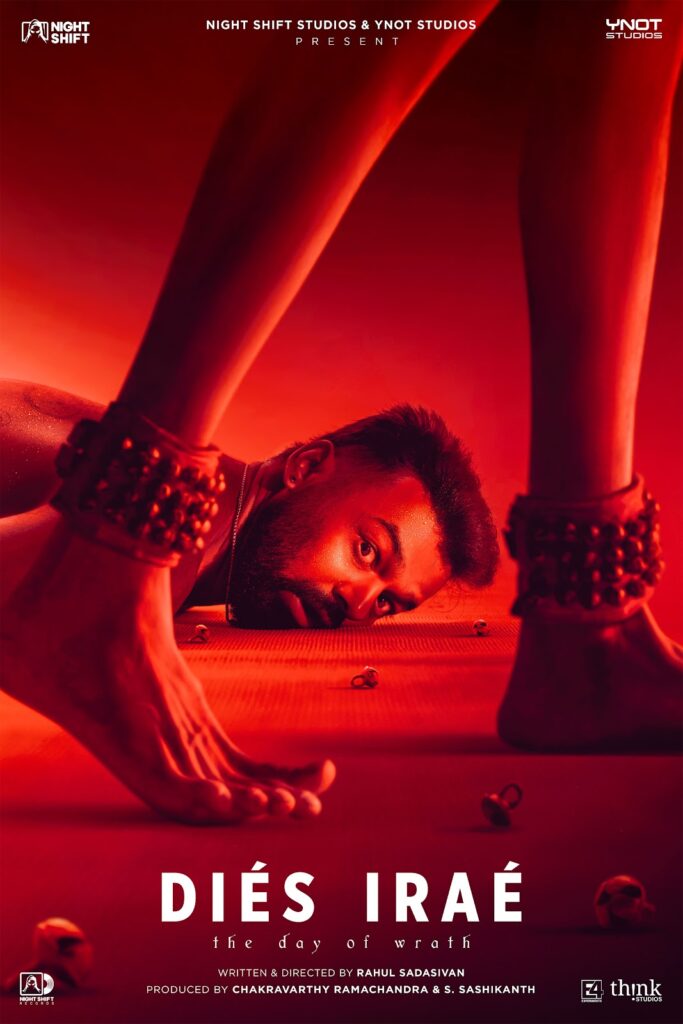Dies Irae
Introduction
The ominous signs in the new Malayalam film Dies Irae are sown right at the beginning during its chilling cold open, that sets the ball rolling here. If it is the twisty spiral of the camera depicting a cement churner, or the uneasy atnospherics that accompany a construction site culminating into a tea cup breaking – the eerie nature of the drama is reflecting in these smaller moments that collectively formulate a picture that would borrow the familiar tropes of the horror genre and literally turn them on their head. And these themes even extend to some of its characters. The Christian doctrine of trinity comprises of the Father, the Son, and the Holy Spirit – each of which is represented through a character here, dead or alive. And yet, one of the important themes that binds these characters together is that of attachment, something on the lines of how the Holy Trinity cannot exist in isolation – just as how each of the characters here can’t. This, even the starting point of every character is detachment – some aspirational and some subsciously out of compulsion.
Story & Screenplay
Written by Rahul Sadasivan, the parallels of Dies Irae (a latin word for The Day Of The Wrath) with Rahul’s previous works Bhoothakaalam (2022) and Bramayugam (2024) cannot be denied. While the former dealt with the concept of generational trauma being passed from the grandmother to the grandson, the latter held a stark commentary on the oppressive caste culture prevalent in Kerala in the early ages. The strains of both these concepts exist in this drama too even as you are introduced to the character of Rohan (Pranav Mohanlal) and Madhusudhanan (Gibin Gopinath). And both cannot be further than chalk and cheese.
Rohan is evidently detached from his relationships, living a life of luxury in his huge penthouse, often seen partying or snifting his way through drugs or even indulging in casual flings along the way. In a scene when his friend breaks him the tragic news of Kani, he responds with the words ‘Who Kani?’, even though the duo had a shared past that translated into a fling. It is safe to say that Rohan is seeking for escapism from his reality and relationships, hardly being attached to his own family or even his pregnant sister, all who are reduced to the backdrop in Rohan’s life.
On the other hand, Madhusudhanan shares a heavy dose of attachment with his mother who is now on her final leg in life. There is an uncertainty in his life whether it is with respect to his future sans his mother, or the generational ‘gift’ of exorcism (from the Potti bloodline in Bramayugam?) that he completely brushes aside while working as a contractor. It is safe to say on how the common thread of attachment for these characters is attachment itself, featuring a ghostly figure that begins to traumatize Rohan after he ‘borrows’ hairclips from Kani’s house.
There is a sinister energy flaunted in the proceedings that heavily relies on the atmospherics to convey an eerie nightmare to the viewers. Be it the objects in the form of hairclips or the sound of anklets (Manjulika anyone?) or even the subtle whistles in the air that has a chilling effect on the drama. As a subtext in its technical form, it is a deconstruction of the familiar tropes of the horror genre wherein the writer doesn’t necessarily rely on jump scares (there are a couple brilliantly infused in the narrative), but instead borrows these tropes to create a far scarier picture. Be it the sight of broken bones displayed in its full glory even as a character is covered with blood, or the presence of a ghostly figure at the halfway mark that is a followup of the antics faced by the character of Rohan, the nightmare peaks in the first hour.
The mood slightly changes in the second hour even as the drama transitions from a horror to an investigative thriller of sorts, thereby slightly dropping the gathered momentum of the first hour. Mind you, the events are still engrossing but this has more to do with your expectations that craved for the nightmare of the first hour to linger on for just a little longer. But even with the (re)introduction of the character of Elsamma (Jaya Kurup), the third (living) wheel of the holy trinity, the theme of attachment remains common even as the character is dealing with a tragedy of her own. It is almost as if this single word combines the living and the dead in this world, something that also accounts for their contrasting character arcs – one that would go from detachment to attachment, and the other from attachment to detachment. If you look closely, the concept of life, death and the after-life co-exist between these traits, even as the shocking revelation in the drama leads to a terrifying end.
And with a nod to Rahul’s previous films, a new horror universe is in the reckoning – something that isn’t as surface-level as the MCHU but something far more deeper on an emotional and psychological level. This, even as the twisted finale does open the door for so many fan theories and discussions that would keep your circles invested. And yet, the theme of attachment isn’t overlooked even in that moment. That is the brilliance of this horror drama that goes beyond the jumpscares, and even the moments of scare while successfully lingering on, long after the film has ended!
Dialogues, Music & Direction
The dialogues are sparingly used, almost as fillers in the drama while the focus remains on the ambience and atmospherics of a scary movie. The film is technically so proficient that every department deserves a shoutout. The background music by Christo Xavier reeks of the 70s gothic era, almost being a nod to Nosferatu while incorporating the sounds of trumpets – a symbolism for the judgment day or the day of the wrath. The atnospherics are chilling and much of the credit also goes to the sound design department wherein Raja Krishnan and Jayadevan Chakkadath manage to create fear out of inanimate objects. Be it the sound of a hairclip or even the rustle of leaves, the fear created out of thin air is a sight to witness in a theatre.
Shehnad Jalal brilliantly utilizes the setting of a haunted house with frames that evoke a sense of fear in you, simply while playing around with its ambience. His cinematography is beautifully complimented by a lighting that exudes of hues of red and white that create a hellish ambience, even as you see a character gape in fear witnessing the white light fade into oblivion. These are the kind of moments that keep you invested, simply because of the tight framing that doesn’t give you an inch to breath. The production design is emaculate, as is the work by the prosthetics department that deserves a huge shoutout.
The editing by Shafique Mohamed Ali is all about delaying the inevitable, allowing the atmospherics of the drama to linger on before quietly squeezing in a jump scare for a fraction of a second. This, while the editing pattern fully commits to the gore and violence in the narrative without cutting away, almost like infusing these elements in the already nightmarish narrative.
Director Rahul Sadasivan is the undisputed (mad)king of the horror genre, probably the best we have in our country at the moment. And his craft emerges from the complexities of individuals rather than external factors that are contributing factors to the genre. It is almost like Rahul understands and borrows the themes of loneliness and trauma here amidst a society divided on caste, while quietly incorporating a life lesson on unity, attachment and detachment through his character. Further, he uses the medium of horror to convey his messaging, to the point that each of these borrowed themes have contributing factors to the genre itself, as opposed to allowing the genre to overpower the narrative with external jumpscares. And this is a sign of a director who is perhaps the finest in contemporary times, explicitly flaunting his chops in a genre that will soon be synonymous with his name.
Performances
The performances are excellent by the members of the cast, and at the cost of avoiding spoilers, I shall be concealing the names of a few characters. The likes of Sushmitha Bhat and Shine Tom Chacko have a tremendous impact on the narrative, wherein their presence makes for an enticing watch. Athulya Chandra as Tessa and Swathi Das Prabhu as Vinoy are wonderful additions, and each of them aide the unique qualities of the protagonist while coming across as competent in their respective acts. Arun Ajikumar as Kiran is wonderful here, even more so when his physicality comes into play with respect to his character. His twitches and movements are contributing factors to the fearful ambience of the drama. Manohari Joy as Madhusudhanan’s mother is sincere and earnest here.
Jaya Kurup as Elsamma has a searing arc to play with, more than is opposite to that of Rohan. Given her presence amongst the dead, the idea was that of detachment that would be the driving aspirational emotion of her character. And despite a (relatively) limited screentime, she puts forth a complex act that will make you sympathize with her even whilst being on tenterhooks with respect to her antics. Gibin Gopinath as Madhusudhanan is excellent here, allowing his expressive eyes and body language to convey the palpable fear of his character. And yet, his approach remains understated and that adds the required stillness to the narrative, almost doubling up as a symbol of hope.
Pranav Mohanlal as Rohan is brilliant in a career defining performance here. Not only has he vastly improved from his previous film, you see him coming of age with a character that is edgy and relentless. His biggest achievement lies in how his performance makes you invested in his journey even when his character isn’t really affable while being a f*ckboi to begin with. His arc lies in that of realisation, or specifically from being emotionally inept to having a sense of attachment, that would necessarily drive people who are alive. And he does a superb job here.
Conclusion
Dies Irae is a chilling ‘Halloween’ horror worth a million nightmares of epic proportions, something that lingers on long after the film has ended. And yet again it is the Malayalam Film Industry at the center of things – quietly raising the bar of horror films, even as someone like me with a high threshold for horror was sitting frightened on his seat for the entire duration of the film. And you just know that the horror has worked when you head home all sweaty and terrified! Available in a theatre near you and Highly Recommended!





